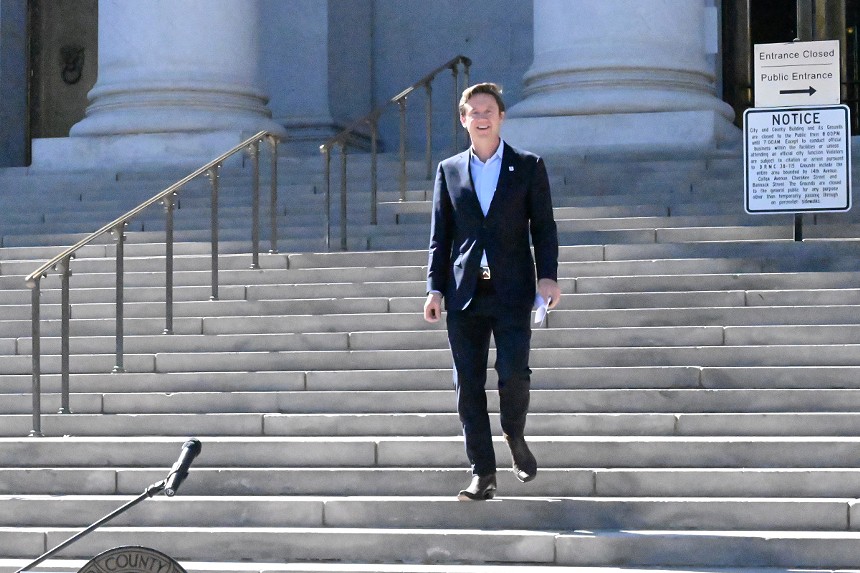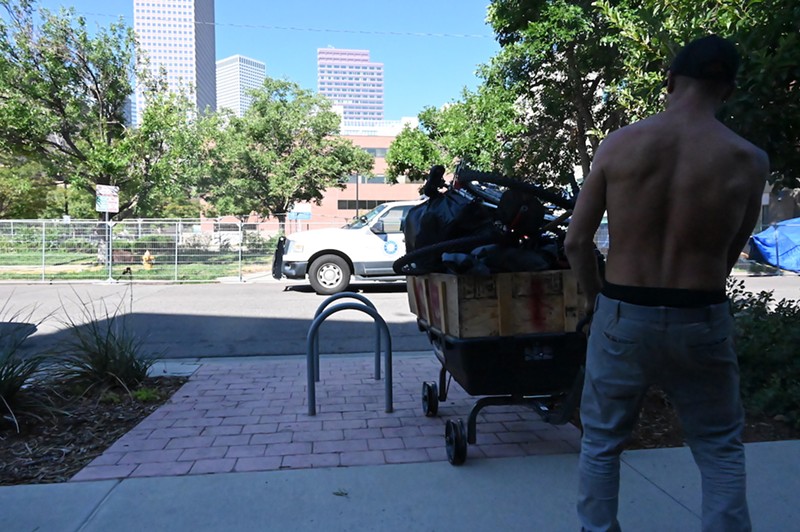Mayor Mike Johnston has publicly vowed to move 1,000 homeless Denver residents off the streets and into housing by the end of the year through the use of micro-communities and converted hotels. However, it appears that he's also created a narrow pipeline for people to get these new housing opportunities, making encampment sweeps one of the lucky few ways to actually be a part of his House1000 plan.
Last week, the mayor celebrated the September 26 encampment cleanup in front of the Governor's Mansion, at Eighth Avenue and Logan Street, saying it was "the first time in Denver's history to move people from the streets to housing."
However, the city only had seventy units available at the newly acquired Best Western Central Park on Quebec Street at the time. The mayor did announce during a September 28 press conference that his team "was able to find another thirteen," bringing the total number of people housed from the sweep up to 83. But these individuals, too, had to be swept first — with no public avenue established (yet) by Denver officials to allow for walk-ups or voluntary sign-ups outside of the sweeps.
"We originally only had seventy units, so we focused on this site as the first location because that encampment had about seventy residents," Johnston said. "It was the right size to be able to move people into the units we had. It was a great success."
But ultimately, the Governor's Mansion sweep pointed out a major issue with Johnston's housing initiative: Many people who are absent from an encampment — owing to work and other obligations — are missing the chance to sign up for housing when city workers come by in the days before the sweep.
Two homeless individuals, Maurice Richardson and Mindy Polson, told Westword after the sweep that they'd lived at the encampment for weeks but couldn't sign up for housing because they were either at medical appointments or court dates. City workers told them to go to shelters instead.
When asked about the situation, Johnston said that "the reason people didn't get access to housing was because the numbers increased" after city workers had already started signing people up.
"We did learn something from this site, which was that once we went to talk to the residents at that encampment to tell them we were moving them to housing, word got out," he said. "There were another fifteen, twenty, 25 people who then showed up at that site believing they would have access to housing."
Homeless residents who showed up late that day were put onto a waiting list, according to Johnston. Several people were hopeful about the opportunity but were already on their way to another camping spot as they moved out.
"We do know who those folks are," Johnston claimed of the people who showed up too late to snag a unit.
"We have their names and contact information," he said. "We have them on priority lists as additional units become available."
But according to some of those residents, the only way to find decent housing is to be in the right place at the right time — during one of Johnston's sweeps.
At the September 28 press conference, Johnston rejected that idea; he maintained that the city offers "plenty" of ways to get housing, but didn't specify what those were.
"It does not mean it's the only way," he insisted. "There are plenty of ways, but from the beginning, we have focused our strategy on being able to solve two problems at the same time."
The two problems Johnston says the city is trying to solve are getting people into "stable, dignified housing" and "closing encampments around the city and keeping them permanently closed." But he hasn't named any other specific ways for a homeless person to get decent housing through his House1000 initiative besides finding themselves in a sweep.
Being housed through Johnston's plan ultimately means more personal space for each homeless resident, as the mayor plans to rely on individual units at converted hotels and tiny homes rather than putting people in shared or congregated spaces like shelters.

Mike Johnston says that the city offers other ways to house people besides just collecting their names during a sweep.
Bennito L. Kelty
The people involved in the Governor's Mansion sweep, for instance, balked at the idea of moving to a shelter because of concerns about safety, cleanliness and not being able to take all of their belongings. Still, the city insists that shelters are the way to go.
"While closing encampments and bringing people indoors from unsheltered homelessness are the primary goals of this initiative, other avenues to gain access to case management, shelter and housing services remain in place," says a JIC spokesperson. "If individuals were not able to get on a list, we encourage folks in that situation to take advantage of the shelter system until other resources become available in the coming weeks and months."
Like Johnston, city officials haven't been able to offer examples of ways that homeless people can sign up for housing under the mayor's House1000 plan that didn't already exist before he was in office. "There are many other established programs and investments underway, all with the goal of resolving episodes of homelessness," says Derek Woodbury, spokesperson for the city Department of Housing Stability.
"This includes [HOST] investments into overnight shelter and day shelter, shelter alternatives like Safe Outdoor Spaces and Safe Parking, Denver Basic Income Project support, and street outreach that isn’t directly connected to an encampment closure," he tells Westword.
The city has a website that offers more information on shelters, including where they are, when they're open and how to get in. But then there's also a tab labeled "shelter alternatives" — which are options like tiny villages and non-congregate shelters — and a notice is written underneath each option saying, "Check back soon for more information."
Shelters have become a last resort for many homeless residents, like Richardson — who is battling cancer and says he would rather stay on the streets because of places like the Denver Rescue Mission's Lawrence Street Shelter being "too filthy" for him.
"I would've have liked to be put in one of those rooms [at the Best Western]," he said after the Governor's Mansion sweep.
Homeless residents from previously swept encampments have also had issues with the Lawrence Street Shelter.
A veteran named Kevin Anderson, who was moved out of an encampment on the 1700 block of Logan Street, said he chose to stay unhoused because the shelter was his only option. "They've got a lot of rules about what you can do, when you can leave, when you can come in, what all you can bring with you," Anderson said during the August 24 sweep. "What I'd really like is housing."
Anderson also pointed out how the city is buying and converting hotel units that people who aren't swept have no apparent access to, saying, "I would like to find myself in one of those...that would be much better than a shelter or out here on the street."
Johnston has been making an effort to change the terminology used for city cleanups, though he's not consistent.
Rather than say sweep, Johnston urges people to use the term "closure," despite him previously saying he would "decommission" encampments and not close them.
"This is a closure of an encampment. It is not a sweep," he said at last week's press conference. "The idea here is fundamentally different. The reason we focused on not doing sweeps — except when we had to in cases of public health or safety risks — is that the focus was to move toward closures."
The difference, Johnston said, is that the cleanups don't move people into housing, just away from where they're currently camping. With closures, though, "you want to move people out of encampments and into transitional, supportive housing."
"'Sweep' is the term that was used when you have no place to move people," Johnston added. "The concept behind sweeping — which I think is an offensive term but has been used in casual conversation — is that because there was no place to go, you were literally pushing them from one block to the next."
Denver police officers have been using the term "soft-enforcement operations" to refer to sweeps that happen without ticketing or arrests, as opposed to "hard-enforcement operations" like the one at the Governor's Mansion, according to department officials.
The mayor has only carried out three "hard" sweeps — one for public health reasons, the other for safety. Homeless residents during both reported not knowing where to go, though city workers did offer recommendations and even handed out lists of other encampments. At "soft" sweeps, police officers don't offer any recommendations for where to go.
Johnston admitted last week that the Governor's Mansion cleanup taught him that homeless residents will go to encampments that are about to get swept as a way to find housing. He said that next time, the city will be prepared.
"For us, that was a sign that this is what's going to happen," Johnston said. "When we offer housing, people are so anxious to get access to that, we will see migration into encampments where we're doing rehousing. We're prepared for that, we'll learn from that, we'll adjust the size of housing units that we move forward on with that."












